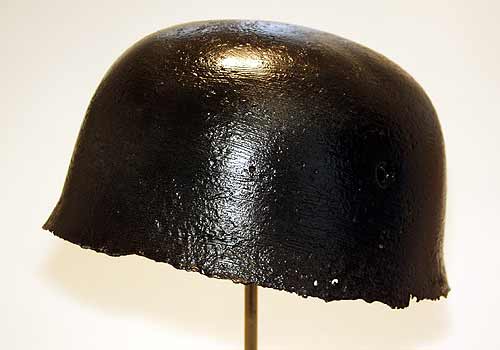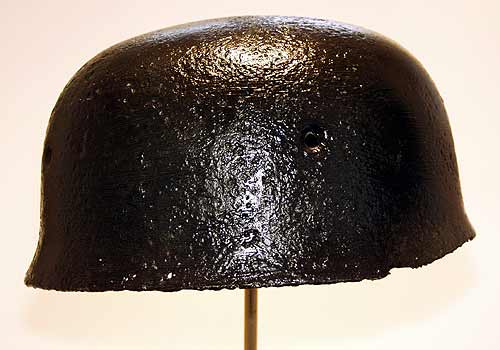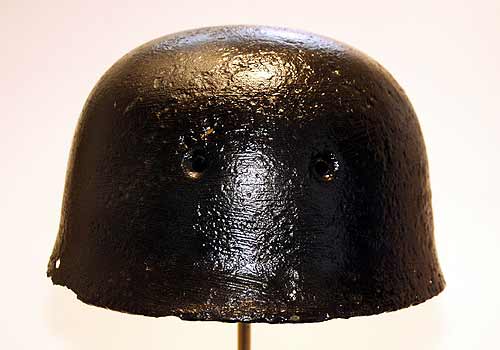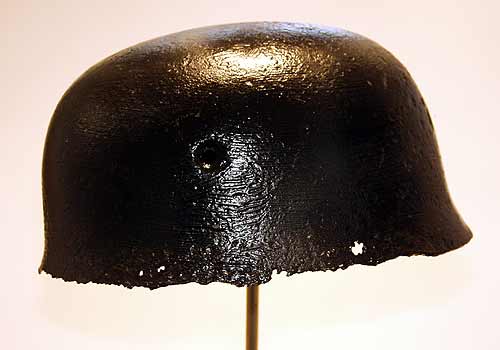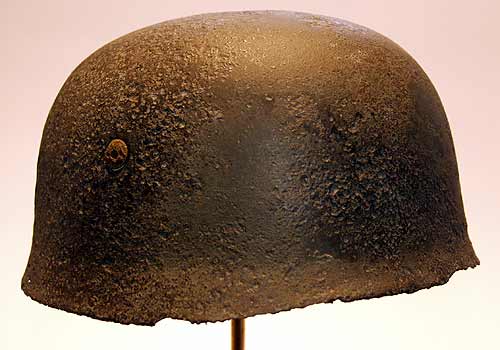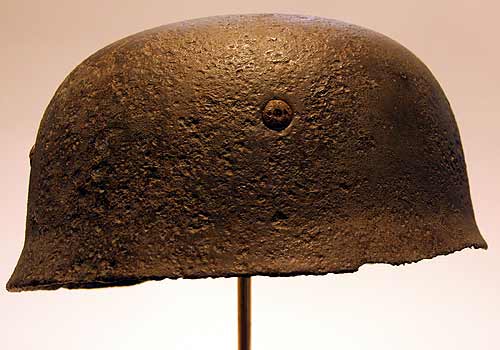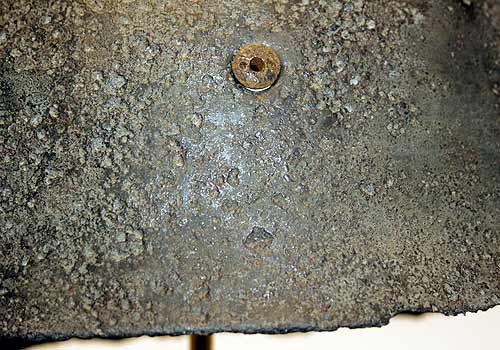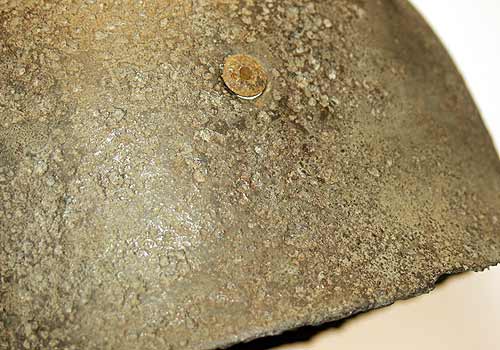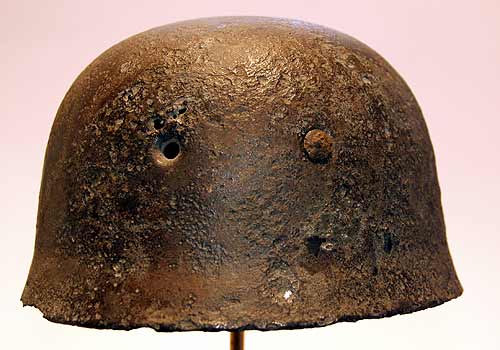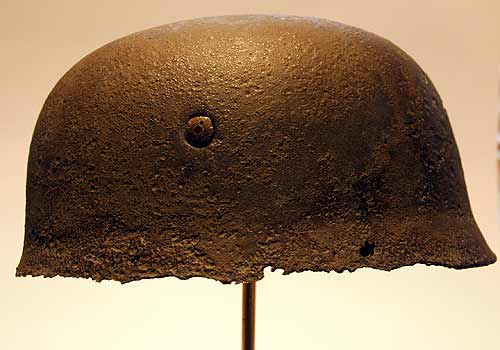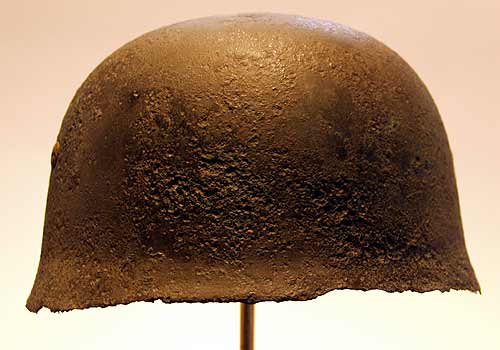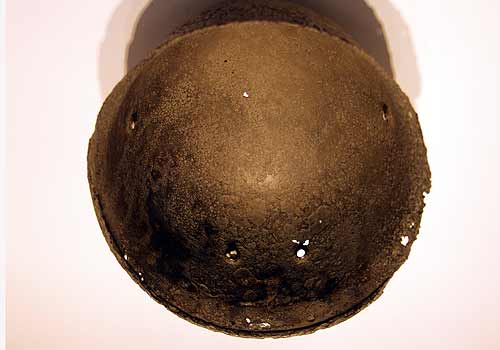 |
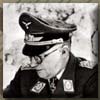 |
 |
 |
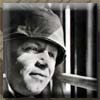 |
| Menu: |
| Home |
| Store |
| Buying |
| X-Sales |
| Info |
| FAQ's |
| Contact |
| Links |
WW2 German Paratrooper Helmet - 7th Airborne Division Russia 1941 This was an interesting find and my second Fallschirmjäger helmet restoration project with great historical German paratrooper helmet and unit interest. I was offered this relic helmet in late 2007 but because it was obviously heavily repainted and the owner wanted quite a large amount of money for it, I declined. I neglected to ask where it was found. In June 2008 the owner contacted me again as he needed to sell it. After several email discussions it became clear that it had been found in the woods in the Ssinyavino area of Russia. So after doing some research into this period of Russian / German conflict I knew I wanted this helmet! After several discussions and negotiations I eventually managed to secure the helmet and it arrived mid July 2008. It was clear that I needed some serious paint remover in order to tackle this restoration as not only had it been painted with Hammerite but had a base layer of grey spray car primer! Just as an aside, I discussed the painting with the previous owner and he acknowledged that it was probably the wrong thing to do but at the time thought it was best to preserve the helmet. |
| I used fine furniture strength paint stripper on a small area inside the helmet to test the suitability and strength of the stripper. I was very pleased to find that this took of the Hammerite and loosened the grey primer. So with large amount of cloth and stripper I worked my way around the whole helmet. Suffice to say it was a very messy and laborious job! I did not use any wire wool as i did not want to damage anything original under the modern paint. |
| I took particular care around the left and right hand sides of the German Paratrooper helmet as I did not want to destroy any decals if they existed. The technique I used was to paint on a small amount of stripper, leave for approximately one minute and then wipe away. This ensured that only small layers of paint were removed. I would like to say it was incredibly hard to remove the modern paint from the deeply rusted cavities! |
Once stripped and when I was very close to the original paintwork I used cloth and white spirit to get to the original layer of the helmet, suffice to say this was exciting! I worked my way round the whole helmet slowly revealing the rusted and original paintwork, yes I got down to original paint in several places unaffected by rust! |
Again, when it came to the decal area's I took great care to ensure I broke through to the original paintwork carefully. On the left side (as worn by the owner), you would expect to find a Luftwaffe eagle, but alas nothing was found. Not even a single spot of decal. I did the same on the right hand side where it was even more unlikely to find anything as decals on this side (the National colour's), were ordered to be removed in 1940. |
I am convinced I had managed to reveal the remains of a National colour's decal. Picture 7 above and picture 8 below shows (almost!), that you can see the remains of the black part of the decal and the outline shape where it is less rusty than the rest of the helmet. It is difficult to see this from the photographs and can be seen much clearer in natural light. |
The shell, colour and bolts all support an early war Fallschirmjager (German Paratrooper), helmet. The bolts had come with the helmet but had been removed and of course each of them had sheared during removal! This is another good reason for leaving relic helmets alone! I reattached the spanner bolts with some blue tack purely for photography purposes but will look at a 'safe' method to re-attach them permanently. Enjoy the rest of the pictures, I am very pleased with the results of my 'archeology' and I think you will agree the helmet looks much better in a natural state than 'Hammerite Black'! Now the history of 7th Airborne Division in Russia 1941: |
| After the battle for Crete, the 7th Flieger Division was ordered back to its bases in Germany for rest and refitting. Operation Barbarossa (the invasion of Russia), was to start without the Fallschirmtruppe. However, at the end of September 1941 parts of the division were mobilized, ready to be sent eastwards to fight as conventional Infantry. The 1st & 3rd Battalion's, 1st Regiment under the command of Generalmajor Bruno Bräuer and the 2nd Battalion of the Sturm Regiment under the command of Major Edgar Stentzler were sent to the German 18th Army (Army Group North) on the Leningrad front. |
Leningrad was situated on the eastern end of the Gulf of
Finland, the river Neva ran through it and 30 miles to the
east was Lake Ladoga. The German forces backed by the Finns
attacking from the North, had partially encircled the city.
The Russians held some ground on the western side of Lake
Ladoga but their foothold was being pressurized by Finnish
forces in the North.
|
| It was on the River Neva that the first Fallschirmjäger
units were to see action on the Ostfront. Units of the 2nd Battalion,
Assault Regiment backed up by the 2nd Kompanie of the Fallschirm
MG Battalion managed to hold back numerous attacks by Soviet
armour and massed infantry. They took heavy casualties in the
process. On the 7th October the men of the Sturm Regiment were
pulled out of the line to deal with another Russian attack on
a different sector of the River Neva. The 2nd & 3rd Battalion's, 3rd Regiment under the command of Oberst Richard Heidrich, reached the Leningrad front on the 1st October 1941. They were to provide flank for the newly situated Assault Regiment on the Neva, counterattacking small Russian bridgeheads. The 7th Flieger Division's HQ arrived at the front in mid October and took command of the sector held by the men of their division. Two kompanies of the Fallschirm-Pioneer Battalion under the command of Major Liebach arrived shortly after and went straight into action in woodland on the west side of the Neva. |
It was in its woodland area of Ssinyavino that the Russians had concentrated huge amounts of men and material to try and break through to Leningrad. The Engineers put up a brave defense in the woods of Ssinyavino, many tanks being destroyed by grenades and mines. Russian troops advanced en-masse and were cut down by heavy German MG fire. The Fallschirmjäger held back the Russian onslaught but suffered heavy casualties. On the 16th November the pioneer's were pulled out of the line after being relieved, they were returned to Germany to be rested and refitted. By December the Fallschirmjäger in the Leningrad area were pulled out and sent back to Germany. In the meantime the 2nd Regiment had been in Germany held back as reserve. This was short-lived as they were soon to be mobilized. In November, Army Group South fighting in the Ukraine, was on the defensive. The harsh Russian winter had set in and the German advance had started to slow down. The Soviets taking advantage of the harsh weather launched attack after attack. Army Group South found itself over stretched in the Ukraine and there was a serious need for reinforcements. The 2nd Regiment along with the 4th Battalion of the Assault Regiment and one kompanie from the Anti-Tank and MG Battalions were formed into a kampfgruppe and sent to the Ukraine to bolster German forces. This Kampfgruppe commanded by Generalmajor Alfred Sturm, were ordered to defend a sector along the River Mius around the town of Charzysk. They defended this sector throughout the winter of 1941 and into the early months of 1942. The winter took its toll on Sturms men and heavy casualties were incurred just from the weather. 3000 fallschirmjaeger were killed, wounded or listed as missing in that first winter in Russia. |
| Based on the evidence of where this helmet was found, it is highly probable that this helmet belonged to a Fallschirmjager of the Fallschirm-Pioneer Battalion under the command of Major Liebach. A truly historical find and one which I was glad to have helped to restore to its resting place condition. |

